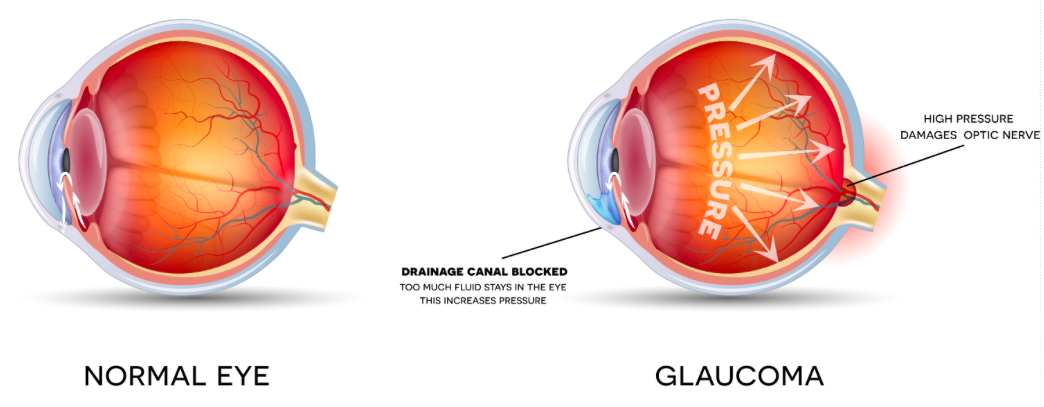Glaucoma

What is it?
Glaucoma is a condition where 3 things can happen. The first is the pressure can increase within the eye, secondly this can damage the optic disc and surrounding retinal nerves, and finally this can cause loss of peripheral vision.
The pressure in the eye is similar to car tyre pressure. The pressure needs to be at an optimum level for the car tyre to run and function properly. It is the same principle in the eye.
The optic disc is the area in the eye where all the nerves come together and form a long tube sending all the information to the brain.
Peripheral vision is your side vision that we use when driving and walking.
Types of glaucoma
There are a few types of glaucoma:
- Chronic (open-angle) glaucoma – this is the most common type of glaucoma and develops very slowly.
- Acute (angle-closure) glaucoma – this is rare and may develop rapidly with a sudden, painful build-up of pressure in the eye. Other symptoms may include blurred vision and haloes around lights.
- Low-tension or normal tension glaucoma. Occasionally optic nerve damage can occur in people with so-called normal eye pressure. This form of glaucoma is treated in the same manner as open-angle glaucoma.
- Secondary glaucoma. This can develop as a result of other disorders of the eye such as injuries, cataracts, eye inflammation. The use of steroids (cortisone) has a tendency to raise eye pressure and therefore pressures should be checked frequently when steroids are used.
How common is it?
- One in eight Australians over 80 will develop glaucoma.
- 50% of people with glaucoma remain undiagnosed.
Source: https://www.glaucoma.org.au/what.htm
Risk factors for glaucoma include:
- A family history of the disease
- Higher levels of short sightedness
- Raised pressure in the eye which is called ocular hypertension (OHT)
You are also at increased risk of developing chronic glaucoma if you are of black-African or black-Caribbean origin.
Glaucoma In families
Having a family history of glaucoma puts you at greater risk of developing glaucoma. Direct family members (parents, siblings and children) of a person with glaucoma have an almost 1 in 4 chance of developing glaucoma in their lifetime.
- Have a family history of glaucoma
- Are over the age of 40
- Have diabetes or migraines
- Are short or long sighted
- Take cortisone drugs (steroids)
- Have had eye surgery or an eye injury
Source: https://www.glaucoma.org.au/about-glaucoma/who-is-at-risk
What causes it?
The eyeball contains a fluid called aqueous humour which is constantly produced by the eye. There is an area of the eye that produces this aqueous humour and a drainage system for the outflow. Glaucoma can occur if the production of aqueous is high or the drainage is blocked.
Glaucoma develops when this increased pressure damages the optic nerve (which connects the eye to the brain) and the nerve fibres from the retina (the light-sensitive nerve tissue that lines the back of the eye).
In acute glaucoma cases this pressure rises rapidly to higher levels, causing pain.
Diagnosing glaucoma
Glaucoma can be treated but early detection is important. If left untreated, glaucoma can cause visual impairment and damage that cannot be reversed. But if it’s detected and treated early enough, further damage to vision can be minimised or prevented.
If you have chronic glaucoma, it can take a long time before you realise you have a problem with your eyesight. This is because chronic glaucoma is painless and usually damages the outer edge of the vision and works slowly inwards. Without regular eye tests you may not notice a problem until the glaucoma is near the centre of your vision.
It is recommended that people have a regular optic nerve check from age 40. Most people are recommended to have an eye check for glaucoma every 1 year or when advised by their eye health professional.
Tests for glaucoma
There are several tests that can be carried out by the optometrist in addition to the usual examinations carried out during an eye test. They are painless and quick. They include:
-Eye pressure test
An instrument called a tonometer is used to measure the pressure inside your eye – intraocular pressure. We have the latest technology icare Tonometer. https://www.icaretonometer.com/
-Visual field test
During this test you will be shown flickers of light. When you see a flicker you click a button in your hand. If you do not see these flickers in your peripheral vision, it may indicate glaucoma has impacted your sight
-Optic nerve assessment
Your optic nerve connects your eye to your brain. This is checked by observing a 3D image produced using a special lens and slit lamp.
Managing glaucoma
If the optometrist suspects glaucoma, you will be referred to an ophthalmologist for further tests. If the ophthalmologist confirms a diagnosis of glaucoma, they will also be able to provide further information:
- How far the condition has developed
- How much damage the glaucoma has done to your eyes
- What may have caused the glaucoma
They will then be able to advise on a treatment method. In most cases an eye drop used on a daily basis.
